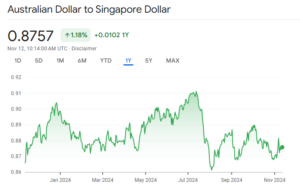AUD to SGD Forecast: Trends, Influences and Predictions
Ujjwal Maheshwari, November 12, 2024
The AUD to SGD forecast is a vital factor for traders, investors and anyone engaged in business or travel particularly to those countries. This forecast is also important for import and export activities between Australia and Singapore. The Australian Dollar (AUD) and the Singapore Dollar (SGD) represent two strong regional economies, and their exchange rate, the AUD/SGD, reflects crucial economic, political, and market dynamics unique to each country.
Understanding the Singapore dollar forecast, and factors impacting the SGD exchange rate is essential to making critical decisions based on the currencies. Along with that, knowing about certain tools like support levels, resistance levels, and how current events could shift forecast for tomorrow or even 1 year down the line is essential.
The Current Status of AUD to SGD Forecast
The current Exchange Rate of AUD to SGD
As of today, the current rate of AUD to SGD has been hovering around 1 AUD = 0.88 SGD. This rate has been subjected to shifts due to both global and regional economic events. The Singapore Dollar forecast is highly impacted by Singapore’s economic stability, which usually tends to buffer against volatility. Meanwhile, the Australian Dollar to Singapore Dollar exchange rate often responds to Australia’s ties to commodity markets, specifically iron ore and coal exports, which Australia relies on heavily for its economic growth.
Historical AUD to SGD Forecast
Over the past year, AUD to SGD has experienced noticeable fluctuations. At the beginning of 2024, its rate hovered around 1 AUD = 0.8851 SGD. On May 22 2024, its rate gradually faced ups and downs and settled at 1 AUD = 0.89 SGD. The highest exchange rate the currencies touched was in July 2024 when 1 AUD = 0.91 SGD. This is a modest appreciation of the Singapore Dollar against the Australian Dollar. These changes stem from various factors, including interest rate policies by the respective central banks and global inflation trends that have affected both currencies in unique ways.
Factors Influencing the AUD/SGD Exchange Rate
Commodity Prices (Impact on AUD)
Australia is a commodity-exporting country, and the Australian Dollar is often referred to as a commodity currency because its value is closely tied to the prices of resources like iron ore, coal, and gold. When global demand for these resources is high, the AUD tends to strengthen. Conversely, a drop in commodity prices can weaken the AUD, creating bearish trade signals for the AUD to SGD pairing.
Economic Policies and Interest Rates
The Reserve Bank of Australia (RBA) and the Monetary Authority of Singapore (MAS) play pivotal roles in determining the exchange rate. As of November 2023, the cash rate stands at 4.35%. This is the highest level since April 2012. However, Singapore manages its currency through exchange rate targeting, keeping the Singapore Dollar relatively stable. This unique approach means that any AUD to SGD forecast must consider not only interest rates but also the MAS’s policy responses to global events.
While higher interest rates can attract foreign investment and strengthen a currency, the relationship between interest rates and exchange rates is complex and influenced by various factors. In the case of the Australian Dollar (AUD), factors like commodity prices, global economic conditions, and risk appetite also play significant roles.
Therefore, while the rate hikes have aimed to control inflation, their impact on the AUD has been mixed. The AUD has experienced both appreciation and depreciation throughout 2023, influenced by a combination of factors beyond just interest rates.
Political Events and Geopolitical Tensions
Political events and tensions, particularly those involving China (a major trading partner of both countries), can have a big impact on the SGD exchange rate and AUD value. Changes in trade policy, tariffs, or economic sanctions can lead to short-term volatility in the Australian Dollar Singapore exchange rate.
Economic Growth Forecasts
Singapore’s economic outlook remains strong, with stable growth rates between 2-3% expected in 2024. Australia’s economy, although healthy, faces more variability due to its reliance on commodity exports. The balance of these economic growth rates influences the exchange rate, with stronger economic performance in one country typically leading to currency appreciation.
Forecast and Predictions for AUD to SGD
Short-Term Predictions
For short-term predictions, analysts look at technical indicators such as support levels and resistance levels for the AUD/SGD pairing. For instance, the RSI (Relative Strength Index), trading charts, and technical tools like moving averages help predict whether the AUD/SGD is likely to face resistance or drop below certain thresholds. In 2024, bearish movements may be anticipated if global demand for commodities declines or if Singapore’s economy grows at a stronger rate.
- Support Level: A key support level to watch might be around 1.05 SGD per 1 AUD. If AUD/SGD falls below this level, it could signal a bearish trend.
- Resistance Levels: Resistance is expected around 0.91 SGD, meaning if the rate rises above this, it could suggest AUD strength.
- Tomorrow’s Forecast: For tomorrow or immediate forecasts, political events, economic releases, or unexpected news can affect AUD SGD sharply.
- Forecast for a Week: Over a week, minor shifts in commodity prices and regional events could move the current rate of AUD to SGD slightly, though it may remain within its recent range.
When a currency pair breaks through a resistance level, it often indicates increased buying pressure and it holds a potential for further upward movement.
Medium-Term Forecast
The AUD to SGD financial forecast could reflect both countries’ economic policies, global economic recovery, and commodity demand. Analysts predict the AUD/SGD may stay near 1.06-1.10 SGD unless significant events disrupt either economy. Investors should monitor updates on interest rates, commodity price shifts, and inflation data as May approaches.
Long-Term Forecast for AUD to SGD: Year and Beyond
Looking further into the forecast for 2024, AUD to SGD may hold within a range, likely around 1.05–1.10. However, several elements could impact this forecast:
- Interest Rate Stability: If Australia’s financial stabilizes its interest rates while the global economy sees no major shocks, AUD may show a sign of slight improvement.
- Commodity Market Recovery: If global demand for commodities like coal and iron ore grows, AUD could see gains against SGD.
- Global Inflation Rates: If inflation remains high in both countries, this could drive unpredictable trading patterns.
Investment and Trading with AUD/SGD: Considerations
For Investors
Investors looking to trade AUD/ SGD should consider using trading tools to monitor currency movements and support or resistance levels. It is vital to follow the current AUD rate and follow the AUD to SGD Forecast to understand how the currency transformation happens. The strength of AUD along with the versatility of the SGD will prove to be a great way of investment for the trade investors. Furthermore, the AUD SGD pair’s performance depends upon the countries’ economic stability as a whole.
For Short-Term Traders
Short-term traders often look for signs of volatility to profit from rapid movements in the exchange rate. Political events or significant announcements from RBA and MAS are key tools for these traders, who typically enter and exit trades within the week, or even on Wednesday, when mid-week rate updates can influence currency movements. AUD to SGD fluctuations provide opportunities to buy and sell positions quickly, depending on the current rate and momentum.
Tools and Strategies for AUD to SGD Investors and Traders
Traders can utilize various tools, including a trading app, technical analysis charts, and live updates, to track and trade the AUD SGD rate. RSI and other momentum indicators are popular for tracking short-term price movements and deciding when to buy or sell AUD/SGD.
Strategies to consider
- Buy and Hold Strategy: Long-term investors engaging in AUD/SGD strength due to economic stability may consider a buy strategy by holding AUD if they expect the dollar forecast to be bullish.
- Short Selling: If the forecast suggests AUD weakness, short-selling strategies allow investors to profit from a declining Australian Dollar in a short period.
- Hedging: For businesses and individuals with AUD SGD exposure, hedging tools can minimize risk. Forward contracts can lock in current rates, providing stability regardless of future movements.
Conclusion: AUD to SGD Outlook
In conclusion, the AUD to SGD forecast depends on a mix of factors. These include commodity prices and interest rates to global political and economic stability. The dollar forecast for AUD SGD suggests a relatively stable exchange rate for 2024. Both long-term investors and short-term traders should stay updated on economic news, political events, and support and resistance levels to make informed decisions with their investments.
Whether you’re an investor looking to buy AUD for long-term gains or a trader seeking short-term predictions from the currency rates, understanding these fundamentals can help navigate the AUD SGD exchange landscape effectively.
What are the Best ASX Stocks to invest in right now?
Check our buy/sell tips
Blog Categories
Get Our Top 5 ASX Stocks for FY25
Recent Posts
How to Calculate How Many Shares You Can Buy: A Simple Guide for Investors
If you’ve ever looked at the share market and wondered, “How many shares can I afford?”, you’re not alone. It’s…
4 Growing ASX Dividend Stocks to Buy and Hold for Steady Returns
Investing in dividend stocks remains a reliable strategy for Australians seeking steady income and long-term capital growth. But which ASX-listed…
3 ASX ETFs to Buy for Passive Income in May
Investing in exchange-traded funds (ETFs) on the Australian Securities Exchange (ASX) has become one of the most popular ways to…




